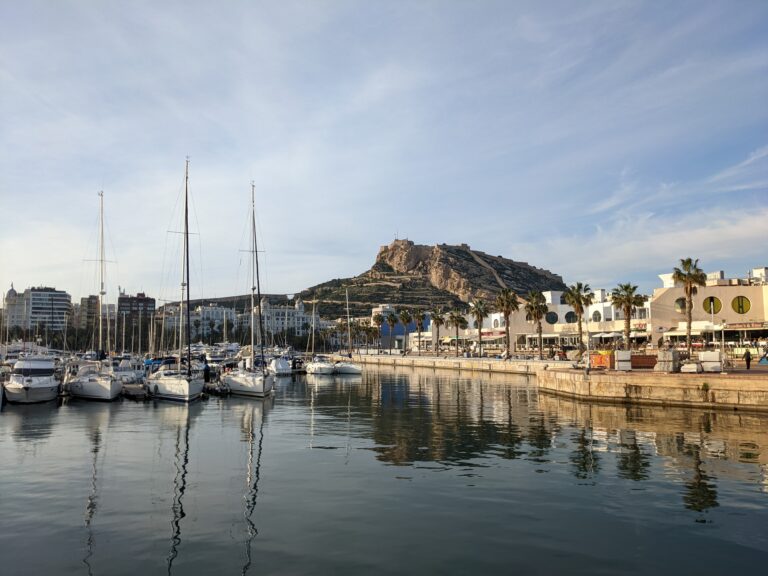Where to Find the Best Weather in Spain (All Year Round)
The climate in Spain varies across the country and so does where the best weather in Spain can be found. The main factors that influence the climate are geographical location and altitude.The weather can affect your travel experience more than you think, so I recommend reading up on when and where to travel in Spain. I have divided the text into different geographical areas, and have tried to keep it short and informative. For more detailed information, follow the links in the article.
The table below already gives a good overview of the different climates.
| Area | Weather in a nutshell |
| South (Costa del Sol, Andalucia) | Hot, dry summer, mild winter |
| Eastern Coast (Valencia, Barcelona) | Warm and humid |
| Inland (Madrid) | Hot summers, cold winters |
| North (Galicia, Barque Country) | Cooler and wetter |
| The Canary Islands | Eternal spring |
Which Part of Spain Has The Best Climate?
The Costa del Sol (Malaga, Fuengirola) has a warm subtropical climate. Summers are dry and warm, winters are mild and humid. The climate is drier in the regions near the equator than in the north.
It is very hot from June to the end of August or even September. If you want to enjoy the sun, warm sea water and the beach, I recommend mid-September to the end of November.
Winter and spring are the ideal time for various activities such as cycling, golf, padel etc. when the air is warm but not hot.
On the Costa Blanca (Alicante, Valencia), summers are hot and dry, winters are mild. Temperatures are almost similar to the Costa del Sol, but with less rainfall.
See Costa del Sol from above
In Barcelona, summers are hot, autumns are pleasantly warm but rainy, and winters are mild and quite rainy. Temperatures are about 2-3C lower than on the Sol or Blanca. August in particular is very hot and humid, but the summer and autumn months are usually more pleasant than on the more southerly coast.
As it rains more in winter than further south, I don’t recommend Barcelona as an outdoor destination in winter, but it’s great for city life and culture even then.
For outdoor activities, I recommend April-June.

The Pyrenees (La Molina) have a mountainous climate. Winters are cold and snowy, summers are cool. Winter is the best time for skiing, downhill skiing and enjoying the snow.
In summer, there is excellent access to hiking and cycling.
Northern Spain (Galicia, Basque Country) has a maritime climate. Winters are mild and rainy, summers are cool and humid.
If you don’t like the heat or the tourists, this could be the place for you!
Winter temperatures are similar to Barcelona, but due to the rainfall, the weather here is often unstable. Summers are certainly more pleasant than on the Mediterranean coast, although rain can be a nuisance at times.
The Canary Islands are subtropical. The climate is dry and warm all year round. The difference between the average temperatures in the coldest and hottest months of the year in Maspalomas, for example, is a mere 7C! (compared to Barcelona’s 14C)
Inland Spain, like Madrid, has a continental climate. Winters are cold and snowy, summers are hot. However, due to the dryness of the climate, both the cold and the heat are not as extreme as one would think from looking at a thermometer.
I recommend avoiding the hottest summer and January.

Where to go and when? Here’s a handy table of seasons and the best areas to visit in Spain:
| Time | Best Area | Why |
|---|---|---|
| January | Canary Islands | +20°C, sunshine |
| April | Andalusia, Valencia | Flowers blossoming, not too hot yet |
| July | Northern Spain | Cooler than the south |
| October | Malaga, Alicante | Sea water is still warm |
| December | Madrid and the Christmas markets. Or Canary Islands |
Tips for preparing for the weather
The weather in Spain can vary significantly depending on the region and the time of year. Here are some tips to help you prepare for your trip with the weather in mind:
- Check the weather forecast for each location before you travel. It can be +30°C in southern Spain at the same time as it rains in the north.
- In spring and autumn, pack in layers. Mornings can be cool, but temperatures rise quickly during the day.
- Sunscreen is needed all year round. Even in winter, the sun is strong, especially in the south and the Canary Islands.
- A raincoat or light umbrella may be necessary in the north. In Bilbao and Galicia, for example, it often rains in autumn. Here in Alicante, I don’t even own either.
- Check if your accommodation has heating or air conditioning. In winter it can be surprisingly cold indoors, especially in old buildings.
Spain Weather FAQ
Is it always hot in Spain?
No. In winter it can be cool or even snowy in the north, and inland (e.g. Madrid) night temperatures can drop to around zero.
Where does it rain the least in Spain?
In southern Spain, especially in the Almería region and the Canary Islands, rainfall is rare.
When is it coolest in Spain?
January is usually the coldest month in the whole country, especially in the interior and north.
Is it possible to travel to Spain in summer, or is it too hot?
In the south, temperatures can reach up to +40°C, but in the north, for example, the weather is pleasant even in summer.
Summary: When and where to travel?
The weather in Spain offers tourists options all year round.
If you want:
- sun and warmth in winter, head to the Canary Islands or Andalusia
- for pleasant spring weather without the crowds, April-May is the perfect time
- to avoid the summer heat, consider northern Spain or the mountain regions
- the warmth of the sea without the masses, September to October offers great travel opportunities
So be sure to check the weather by region and pack your suitcase or backpack accordingly – Spain is more diverse than most people think.
NOW THAT YOU KNOW THE WEATHER…
-
Is August Too Crowded in Spain?
August in Spain brings a certain kind of energy. It’s hot, lively, and full of life. Streets buzz with music, beach towns overflow, and festivals…
-
Spain Summer Packing List: Essentials You’ll Actually Need
Spain in summer is sunny, bold, and full of color – but it can also be really hot. Whether you’re walking through the shaded alleys…
-
Cheapest Places to Visit in Spain in Summer
Spain is packed with summer spots, but not all of them are easy on the wallet. Budget summer travel in Spain is still possible. Luckily,…










